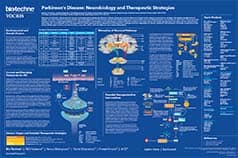LRRK2
Leucine-rich repeat kinase 2 (LRRK2 or RIP7) is a member of the receptor interacting protein kinase family. It is a large multidomain protein kinase that includes leucine-rich repeats and a GTPase domain. Mutations in LRRK2 are commonly associated with late-onset Parkinson's disease (PD). LRRK2 is also known as dardarin.
LRRK2 Inhibitors |
|
|---|---|
| Cat. No. | 产品名称/活性 |
| 6071 | CZC 25146 |
| Potent LRRK2 inhibitor | |
| 4629 | GSK2578215A |
| Potent, selective LRRK2 inhibitor; brain penetrant | |
| 6289 | JH-II-127 |
| Potent and selective LRRK2 inhibitor | |
| 4273 | LRRK2-IN-1 |
| Potent and selective LRRK2 inhibitor | |
| 5756 | MLi-2 |
| Potent and selective LRRK2 inhibitor | |
Leucine-rich repeat kinase 2 (LRRK2 or RIP7) is a large multidomain protein kinase that includes leucine-rich repeats and a GTPase domain. It is a member of the receptor interacting protein kinase family.
The biological function and regulation of LRRK2 is poorly understood, however, the enzyme is constitutively expressed in neurons and glial cells and is associated with certain neurodegenerative diseases. Autosomal dominant missense mutations in LRRK2 are commonly associated with late-onset Parkinson's disease (PD); they are also evident in a smaller percentage of familial Parkinson's disease cases, of which they are the most common cause. The discovery of LRRK2 mutations helped strengthen a genetic link to Parkinson's disease, which had previously been obscured by unusual inheritance patterns - in particular, incomplete/decreased penetrance and variable age of onset. Mutations associated with PD have been isolated within the enzymatic domains of LRRK2, namely its kinase and GTPase domains. The most frequent mutation is a substitution of the Gly2019 residue in the kinase domain with a serine residue, resulting in a kinase that exhibits 2- to 3-fold greater catalytic activity. Pathogenic mutations within the Roc (Ras of complex) GTPase domain and COR (carboxy-terminal of Roc) sequence have been shown to decrease GTPase activity, which is thought to counteract LRRK2 activity and restore it to basal levels. Inhibitors of LRRK2 kinase activity have therefore been of therapeutic interest in the treatment of LRRK2-linked PD.
LRRK2 also contains protein-protein interaction domains. Proteins thought to interact with LRRK2 include dishevelled proteins, MAPK kinase 6 (MKK6) and 14.3.3 proteins. Studies have shown that certain members of the 14-3-3 family bind and influence the cytoplasmic localization of LRRK2. PD-associated mutants and a truncated form of LRRK2 show a decreased ability to bind 14-3-3, suggesting that this interaction is important in the pathogenesis of PD.
The enzyme is also thought to have a role in immune cell regulation.
External sources of pharmacological information for LRRK2 :
Literature for LRRK2
Tocris offers the following scientific literature for LRRK2 to showcase our products. We invite you to request* your copy today!
*Please note that Tocris will only send literature to established scientific business / institute addresses.
Parkinson's Disease Poster
Parkinson's disease (PD) causes chronic disability and is the second most common neurodegenerative condition. This poster outlines the neurobiology of the disease, as well as highlighting current therapeutic treatments for symptomatic PD, and emerging therapeutic strategies to delay PD onset and progression.
